

'Terroir' - "the complete natural environment in which a particular wine is produced, which factors such as the soil, topography and climate.
The characteristic taste and flavour imparted to a wine by the environment in which it is produced .
Might 'terroir' be applicable to apple growing as well?
Certainly soil quality, location, drainage, nutrition, as well as variety, and tree management combine to influence the yield and quality.
But 'Terroir'
The extent of terroir's significance is debated in the wine industry. Over the centuries, French winemakers developed the concept of terroir by observing the differences in wines from different regions, vineyards, or even different sections of the same vineyard.
What about apple growing?
How do the variables influence the yield and quality of apples?
A lot of work has been done over the last few years determining the importance of 'dry matter' in the storage and eating quality of apples.
Five years ago at East Malling Research, DMC was highlighted by Tim Biddlecombe when he presented a Desk Study investigating relationship between Dry Matter Content and Fruit Quality
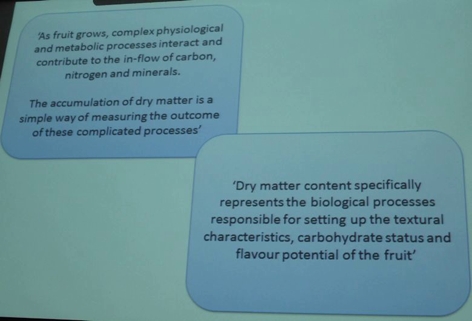
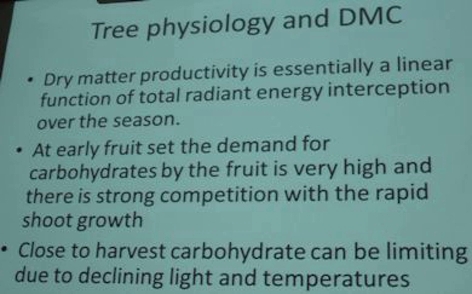
Below: A summary of work carried out by John Palmer in New Zealand on the importance of Fruit Dry Matter (FDM)
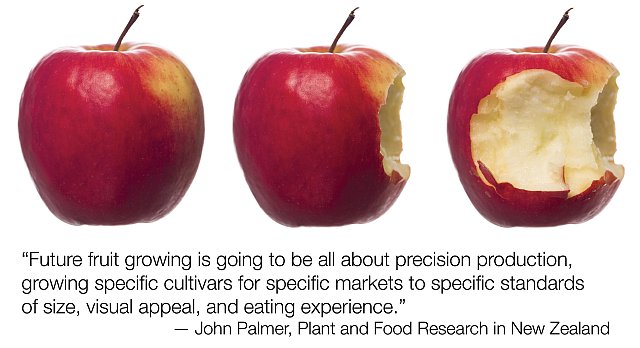 Background: In the fresh apple market fruit must be crisp and juicy to attract buyers to purchase again. However, recent studies have shown that consumer acceptability could be further enhanced by improving taste. This study evaluates the use of fruit dry matter concentration (DMC) as a new fruit quality metric for apple.
Background: In the fresh apple market fruit must be crisp and juicy to attract buyers to purchase again. However, recent studies have shown that consumer acceptability could be further enhanced by improving taste. This study evaluates the use of fruit dry matter concentration (DMC) as a new fruit quality metric for apple.
Results: Fruit samples collected at harvest, in the two main fruit growing regions of New Zealand, showed a variation in mean fruit DMC from 130 to 156 g kg(-1) with 'Royal Gala' and with 'Scifresh' from 152 to 176 g kg(-1).
Individual fruit DMC showed a larger range, from 108 to 189 g kg(-1) with 'Royal Gala' and from 125 to 201 g kg(-1) with 'Scifresh'.
Fruit DMC proved a more reliable predictor of total soluble solids after 12 weeks of air storage at 0.5 °C than TSS at harvest for both 'Royal Gala' and 'Scifresh'.
Fruit DMC was also positively related to flesh firmness, although this relationship was not as strong as that seen with soluble solids and was more dependent on cultivar. Consumer studies showed that consumer preference was positively related to fruit DMC of 'Royal Gala' apples.
Conclusion: Fruit DMC can therefore be measured before or at harvest, and be used to predict the sensory potential for the fruit after storage.
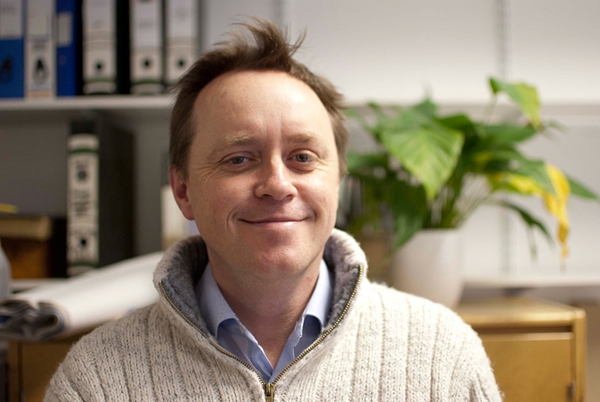 At the recent AHDB Fruit Conference, Richard Colgan summarised a 4 year project carried out by Debbie Rees and himself on dry matter content in Gala apples.
At the recent AHDB Fruit Conference, Richard Colgan summarised a 4 year project carried out by Debbie Rees and himself on dry matter content in Gala apples.
Manipulating Fruit Dry Matter to Improve Long Term-Storage of Gala Apples and overall acceptability (TF225)
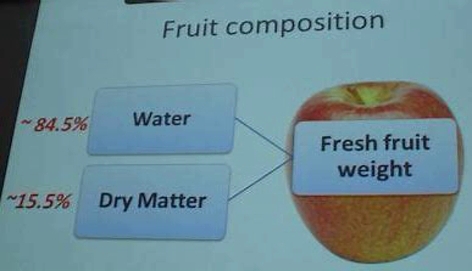 Richard Colgan and Debbie Rees - Natural Resources Institute University of Greenwich; also involved in this funded project TF225 were FAST, NIAB and LANDSEER.
Richard Colgan and Debbie Rees - Natural Resources Institute University of Greenwich; also involved in this funded project TF225 were FAST, NIAB and LANDSEER.
Why is fruit dry matter important? When we talk about FDM we are really talking about the Carbohydrate content - Sugar, Starch and Cell Wall Fibre.
Photosynthates (80% Sorbitol & 20% Sucrose) translocated form leaves to shoots, branches fruits and roots
Photosynthates converted in fruits to starch, sugars and complex cell wall structures
Fruit Dry Matter is 50-60% Sugars (Sucrose/Glucose/Fructose)
Fructose is the predominate sugar
The amount of FDM is dependent on light interception, crop load and competition from shoots, branches and roots.
The fruits are competing with other parts of the tree system for photosynthates (sugars)
So if you have fruits with higher FDM you will have a higher Brix (sugars)
Not all the FDM (Brix) has been determined by harvest and this will continue to develop in store.
FDM correlates with % Brix at harvest and is a predictive tool to estimate % Brix in fruit coming out of store,
So it is not surprising that if you have higher FDM you will have higher Brix.
It is a good metric for predicting the increase in % Brix in store. As the FDM increases in store, so the Brix also increases. John Palmer (ex EMR) did work in New Zealand with Gala.
John found that as the FDM increases in store and Starch turns into sugar, Brix levels at 6 weeks and 12 weeks in store increased predictably.
Techniques to manipulate FDM in the orchard
Pruning to improve light interception (Radiation use efficiency)
Reflective strips to increase light reflectance
Fruit thinning to optimise crop load
Management of tree growth
Root restriction/girding
The English Apple Man Comments: Growing apples (not just apples) is essentially harvesting light, but to ensure the entire crop on a tree has equal light inception, which in turn helps deliver even Brix across the tree and delivers the dry matter for good storage and eating quality goes beyond this with fruit of equal status across the tree.
Below: left; Two dimensional tree management in NZ and right; Multi Stem tree management system in NZ
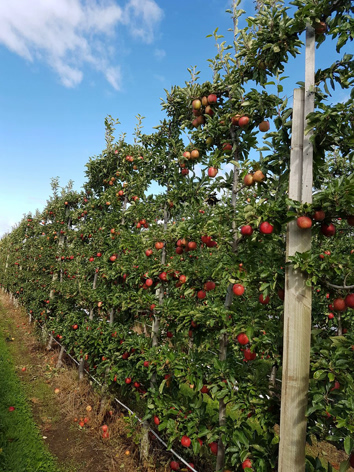
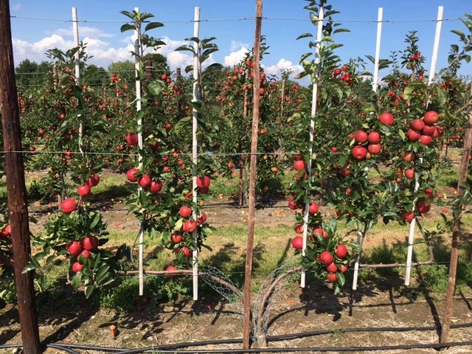
Richard continues: So we set out to understand how we can target thinning to Optimise Dry Matter Accumulation
We collected fruit from a commercial orchard at regular intervals during harvest, took them back to the laboratory and tested for carbohydrate content, looked at where in the natural curve we can influence the FDM.
What is the best time to thin and what does this influence? We looked at the possibility of thinning flower buds before flowers opened, the traditional 10-12mm fruitlet stage and the later 40mm stage for the influence on FDM content.
Techniques to manipulate crop load through thinning practises 2019-2020 FAST LLP
Standard Hand Thinning (15-25mm) - 50 days post full bloom (singles top above 1.5m/ doubles bottom below 1.5m)
Early fruit thinning 10-20mm
Singles - Singles/Doubles - Doubles - Thinning to size 25-30mm, 40mm
Chemical Thinning with Exilis and Brevis
Bud extinction and Mechanical flower thinning
The results show little positive effect from bud/flower thinning and late fruit thinning. The ideal thinning stage is at the 10-12mm stage. But the size profile of 60-65mm increased to 65-70mm. Fruit thinned to singles had higher FDM at harvest and after 6 months in storage had higher Brix levels. Thinning to singles also reduced slightly total yield, but produced more Class 1 fruit.
So what of 'Terroir' - While listening to FAST Advisor James Shellitoe talking about commercial experience of orchards which regularly deliver high yields of apples with optimum FDM for long term storage and excellent eating quality out of long term store, he emphasised that one orchard can "tick all the boxes" while delivering 60 tonnes + per hectare while another may only deliver at 50 tonnes.
This is when I said is that a definition of 'TERROIR' for apple growing?
![]() That is all for this week
That is all for this week
Take care
The English Apple Man